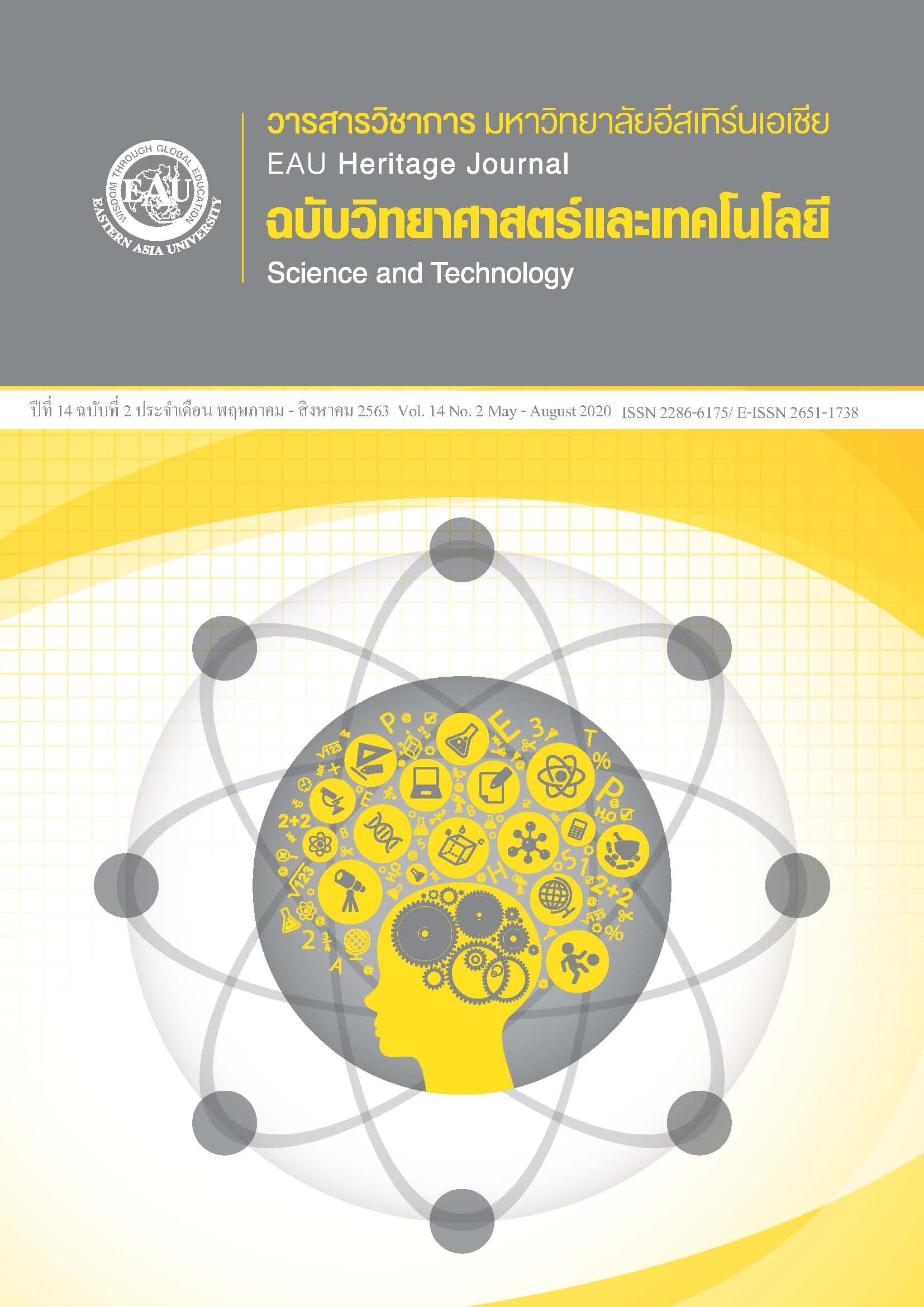การศึกษาความปลอดภัย และประสิทธิภาพของตำรับผลิตภัณฑ์ที่มีส่วนประกอบของน้ำมันรำข้าวที่มีสารแกมม่าออไรซานอลปริมาณ 18,000 พีพีเอ็ม ในการเพิ่มความแข็งแรงของเกราะป้องกัน และความชุ่มชื้นผิวหนังสำหรับคนผิวแห้ง
คำสำคัญ:
dry skin, barrier function, invivo test, safety test, closed patch test, transepidermal water loss, moisturizing effect, irritationบทคัดย่อ
ผิวแห้งเป็นลักษณะผิวที่บอบบาง ง่ายต่อการถูกคุกคามจากปัจจัยภายนอก รังสียูวี สารเคมี เชื้อโรค เนื่องจากเกราะป้องกันของผิวแห้งค่อนข้างอ่อนแอ เมื่อสูญเสียความแข็งแรงของเกราะป้องกัน โอกาสที่จะสูญเสียสารสำคัญภายในผิวก็สูงขึ้น ส่งผลทำให้เกิดความเสื่อมของผิวหนัง ดังนั้นงานวิจัยนี้เป็นการศึกษาความปลอดภัย และประสิทธิภาพด้านการเพิ่มความแข็งแรงของเกราะผิวหนัง ความชุ่มชื้นในคนผิวแห้ง และความพึงพอใจโดยรวมของตำรับผลิตภัณฑ์ที่มีส่วนประกอบของน้ำมันรำข้าวที่มีสารแกมม่าออไรซานอล 18,000 พีพีเอ็ม โดยนำตำรับผลิตภัณฑ์มีส่วนประกอบของน้ำมันรำข้าวที่มีสารแกมม่าออไรซานอลปริมาณ 18,000 พีพีเอ็ม ความเข้มข้น 10%w/w, 15%w/w และ 20%w/w ทดสอบความปลอดภัยด้วยวิธี closed patch test ในอาสาสมัครเพศหญิงและชายที่มีผิวแห้ง อายุระหว่าง 20-50 ปี จำนวน 30 ราย เป็นระยะเวลา 48 ชั่วโมง ทำการประเมินค่าอัตราการสูญเสียน้ำออกจากผิว ด้วยเครื่อง Tewameter® TM210 ศึกษาการเพิ่มความชุ่มชื้นแก่ผิวหนังระยะสั้น (6 ชั่วโมง) และระยะยาว (4 สัปดาห์) ด้วยเครื่อง Corneometer® CM 825 แล้วจึงนำมาประเมินความพึงพอใจด้านต่าง ๆ ณ 4 สัปดาห์ พบว่า ตำรับผลิตภัณฑ์ที่มีส่วนประกอบของน้ำมันรำข้าวที่มีสารแกมม่าออไรซานอลปริมาณ 18,000 พีพีเอ็ม เป็นตำรับที่มีลักษณะทางกายภาพเหมาะสม ด้านความปลอดภัย ไม่ก่อให้เกิดการระคายเคือง ด้านประสิทธิภาพการเพิ่มความแข็งแรงของเกราะผิว และความชุ่มชื้นแก่ผิวหนังระยะสั้น และระยะยาว พบว่า ทั้ง 3 ตำรับ ค่าการสูญเสียน้ำจากผิวลดลง หลังใช้ผลิตภัณฑ์ 4 สัปดาห์ (p=.001) และการเพิ่มความชุ่มชื้นผิวระยะสั้น สามารถคงความชุ่มชื้นได้ยาวนาน 6 ชั่วโมง ด้านการเพิ่มความชุ่มชื้นผิวระยะยาว (4 สัปดาห์) ทั้ง 2 ตำรับ (ผลิตภัณฑ์ที่มีส่วนประกอบของน้ำมันรำข้าวความเข้มข้น: 15% w/w และ 20% w/w) สามารถเพิ่มความชุ่มชื้น หลังใช้ผลิตภัณฑ์ เป็นเวลา 2 สัปดาห์ (p=.001)
เอกสารอ้างอิง
An, S. M., Ham, H., Choi, E. J., Shin, M.K., Kim, H.O., & Koh, J.S. (2013). Primary irritation index and safety zone of cosmetics: retrospective analysis of Skin Patch tests in 7440 Korean women during 12 years. International Journal of Cosmetic Science, 36(1), 62-67. https://doi.org/10.1111/ics.12095
Aramaki, J., Kawana, S., Effendy, I., Happle, R., & LÖffler, H. (2002) Differences of skin irritation between Japanese and European women. British Journal of Dermatology, 146(6), 1052-1056. https://doi.org/10.1046/j.1365-2133.2002.04509.x
Baumann, L. (2002). Sensitive skin. In L. Baumann (Eds.), Cosmetic dermatology: Principles & practice (pp.33-39). New York: McGraw-Hill
Bernardi D.S., Pereira, T.A., Maciel, N.R., Bortoloto, J., Gisely S Viera, G.S., Oliveira, G.C., & Rocha-Filho, P.A. (2011). Formation and stability of oil-in-water nanoemulsions containing rice bran oil: In vitro and in vivo assessments. Journal of Nanobiotechnology, 9, 44. https://doi.org/10.1186/1477-3155-9-44
Rosado, C., Pedro Pinto, P., & Rodrigues, L.M. (2009). Assessment of moisturizers and barrier function restoration using dynamic methods. Skin Research and Technology, 15(1), 77- 83. https://doi.org/10.1111/j.1600-0846.2008.00331.x
E. Berardesca European Group for Efficacy Measurements on Cosmetics and Other Topical Products (EEMCO). (1997). EEMCO guidance for the assessment of Stratum Corneum Hydration: Electrical methods. Skin Research and Technology, 3(2), 126-13. doi: 10.1111/j.1600-0846.1997.tb00174.x
Haratake, A., Uchida, Y., Schmuth, M., Tanno, O., Yasuda, R., Epstein, J. H., Elias, P. M., & Holleran, W. M. (1997). UVB-Induced Alterations in Permeability Barrier Function: Roles for Epidermal Hyperproliferation and Thymocyte - Mediated Response. Journal of Investigative Dermatology, 108(5), 769-775. https://doi.org/10.1111/1523-1747.ep12292163.
Hashizume, H. (2004). Skin aging and dry skin. The Journal of Dermatology, 31(8), 603-9. https://doi.org/10.1111/j.1346-8138.2004.tb00565.x
Hetrakul, T. (2007). Evaluation of the irritation potentials of 4 topical products using occlusive Patch test method (References of products Ellgy H2O extra gentle cleanser, Ezerra cream, Ezeshield cream, Ezetect cream) Hoe Pharmaceuticals. SDN Confidential study (Report Ref D06-6Q02-HE-MI07). Malaysia: Hoe Pharmaceuticals Sdn., Bhd.
Iqbal, J., Minhajuddin, M., & Beg, Z. H. (2014). Suppression of Diethylnitrosamine and 2-Acetylaminofluorene-induced Hepatocarcinogenesis in rats by Tocotrienol-rich fraction isolated from rice bran oil. European Journal of Cancer Prevention, 2004, 13(6), 515-20. doi: 10.1097/00008469-200412000-00009.
Jennings, B. H., & Akoh, C. C. (2009). Characterization of a rice bran oil structured lipid. Journal of Agricultural and Food Chemistry, 57(8), 3346-50. doi: 10.1021/jf803825m.
Juliano, C., Cossu, Ml., Alamanni, M. C., & Piu, L. (2005). Antioxidant activity of Gamma-Oryzanol: Mechanism of action and its effect on Oxidation stability of pharmaceutical oils. International Journal of Pharmaceutics, 299(1-2). 146-154. doi: 10.1016/j.ijpharm.2005.05.018.
Klongpityapong, P., Supabphol, R., & Supabphol, A. (2013). Antioxidant effects of Gamma-Oryzanol on Human Prostate Cancer cells. Asian Pacific Journal of Cancer Prevention, 14(9), 5421-5425. doi:10.7314/APJCP.2013.14.9.5421
Liebert, M. (1983). Final report on the safety assessment of Sodium Lauryl Sulfate. Journal of the American Cole of Toxicology, 2(7), 127-181. https://doi.org/10.3109/10915818309142005.
Olivarius, F. de F., Hansen, A. B., Karlsmark, T., & Wolf, H. C. (1996). Water protective effect of barrier creams and moisturizing creams: A new in vivo test method. Contact Dermatitis Environmental and Occupational Dermatitis, 35(4), 219-225. https://doi.org/10.1111/j.1600-0536.1996.tb02361.x
Petruk, G., Giudice, R. D., Rigano, M. M., & Monti, D. M. (2018). Antioxidants from plants protect against Skin Photoaging. Oxidative Medicine and Cellular Longevity, 2018(Special Issue), 1-11. Article ID 1454936. https://doi.org/10.1155/2018/1454936.
Klongpityapong, P., & JuntarJaricksakulchai, J. (2019). Development of pharmaceutical preparation from rice bran oil for health promotion. EAU Heritage Journal Science and Technology, 13(2), 1-16. (in Thai).







